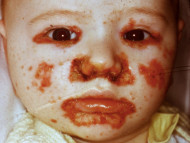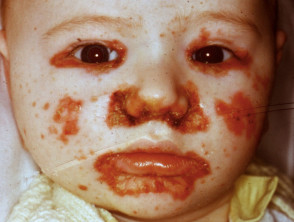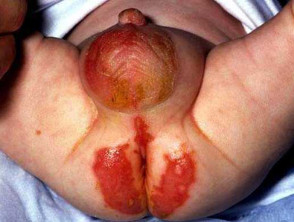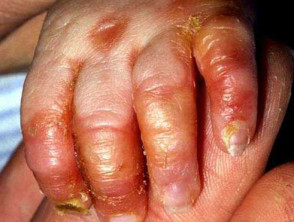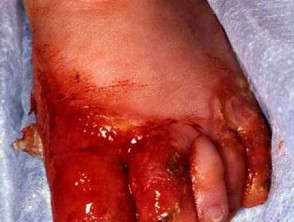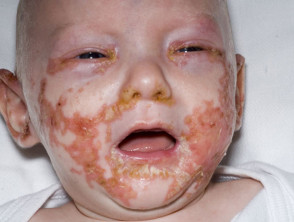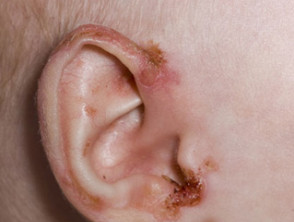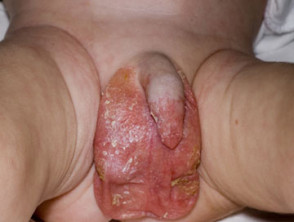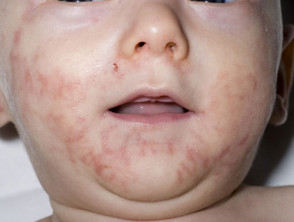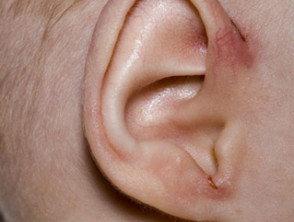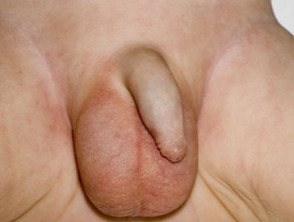What is acrodermatitis enteropathica?
Acrodermatitis enteropathica is a rare disorder associated with zinc deficiency. It presents with the classic triad of:
- Peri-acral and periorificial dermatitis
- Diarrhoea
- Alopecia.
Primary acrodermatitis enteropathica is due to an inherited zinc transporter defect, resulting in reduced intestinal absorption of zinc.
Acquired acrodermatitis enteropathica may be a result of reduced intake, increased demand, malabsorption, or may rarely be associated with certain metabolic disorders. [See Acrodermatitis enteropathica-like conditions]
Pseudo-acrodermatitis enteropathica has been described in biotinidase deficiency, organic acid, amino acid, urea cycle and essential fatty acid disorders [1–5].
Acrodermatitis enteropathica is also called acrodermatitis enteropathy, primary zinc malabsorption syndrome, Danbolt-Closs syndrome, and Brandt syndrome [6–8].
What is the role of zinc in the body?
Zinc is an essential micronutrient with better bioavailability from human milk than cow’s milk or other infant formulae.
- Meat, shellfish and wheat germ are rich dietary sources.
- Phytates (cereals) and some medications inhibit its absorption (chelating agents).
- Zinc absorption mostly occurs in the jejunum and duodenum.
Zinc is a part of over 200 metalloenzymes involved in cellular metabolism.
- Zinc bioavailability and transport are important for homeostasis.
- Zinc has anti-inflammatory and antioxidant properties.
- It plays an important role in normal wound healing, growth, brain development and immune function [1–5,9–11].
What causes acrodermatitis enteropathica?
Primary acrodermatitis enteropathica
Primary acrodermatitis enteropathica is an autosomal recessive genetic disorder and manifests when two defective genes are inherited (one from each parent). Carriers have one normal gene and one defective gene and will not usually have any symptoms of the disease.
The SLC39A4 gene located on chromosome 8q24.3 codes for the zinc transporter protein, ZIP4. A mutation in SLC39A4 disturbs the uptake, transport and overall homeostasis of zinc. Zinc deficiency in primary acrodermatitis enteropathica is secondary to a partial block in zinc absorption across the small intestinal mucosa.
A large number of enzymes require zinc as a cofactor leading to heterogenic clinical manifestations.
Acquired acrodermatitis enteropathica
Acquired acrodermatitis enteropathica may be associated with the following:
- Inadequate zinc intake (vegetarian diet or breast milk deficient in zinc, anorexia nervosa, chronic alcohol consumption, or intravenous nutrition lacking zinc)
- Intestinal malabsorption (inflammatory bowel disease, intestinal bypass surgery [12], cystic fibrosis, or pancreatic disease)
- Excessive urinary loss of zinc (nephrotic syndrome)
- Low levels of albumin and high catabolic states (trauma, thermal burn, extensive surgery, or cirrhosis)
- Necrolytic migratory erythema (glucagonoma) [13].
What are the clinical features of acrodermatitis enteropathica?
Primary acrodermatitis enteropathica may manifest in formula-fed infants within a few days to weeks after birth, and soon after weaning in breast-fed infants. Both males and females are equally affected [1–5,9–11].
Symptoms of acquired acrodermatitis enteropathica may occur at any age, depending on the underlying cause, but mostly affect older children, adolescents and adults.
Preterm infants may present early with acrodermatitis enteropathica due to increased demand and negative zinc balance at birth. Acrodermatitis enteropathica in preterm infants can be due to zinc-deficient breast milk or a mutation of the transporter protein.
Primary and acquired acrodermatitis enteropathica have similar cutaneous and non-cutaneous findings.
Cutaneous features
A form of dermatitis is typically the first manifestation of zinc deficiency. Characteristically, it is found in an acral and peri-orificial distribution.
- There is usually a sharp demarcation between the affected area and normal skin.
- The peri-orificial rash is typically in a horse-shoe or U-shaped pattern with cheeks-to-chin involvement sparing the lips.
- Eczematous or psoriasiform plaques progress to include vesicles and bullae, pustules, erosions or hyperkeratotic areas.
- A red glossy tongue (glossitis), mouth ulcers, and angular cheilitis are often early signs.
- Symmetrical peri-anal excoriations and rash on the buttocks
- Extensor aspects of limbs (elbows and knees) and acral areas (fingers, toes) may also be involved.
- Secondary infection with Candida albicans or Staphylococcus aureus may occur.
- Wound healing is impaired.
Diffuse hair loss affects the scalp, eyebrows and, eyelashes. The nails are soft with ridging, dystrophy and paronychia.
Acrodermatitis enteropathica
Noncutaneous symptoms
Other features of acrodermatitis enteropathica include [1–5,9–11]:
- Blepharo-conjunctivitis and sensitivity to light
- Loss of appetite
- Diarrhoea, mild or severe
- Irritability (babies cry and whine incessantly)
- Depressed mood, apathy, and emotional disturbances in older children and adults
- Growth failure in untreated children
- Hypogeusia (decreased sense of taste)
- Hypogonadism in male adolescents and young adults.
How is acrodermatitis enteropathica diagnosed?
The following investigations may be helpful if zinc deficiency and acrodermatitis enteropathica are suspected.
- Serum/plasma zinc levels — normal non-fasting levels are 9.0–17.0 µmol/L
- Serum alkaline phosphatase — this may support the diagnosis if low
- Serum albumin — note that zinc is a negative acute-phase reactant so that low levels of zinc may be seen if albumin is low or in the presence of inflammatory disease. Special collection precautions may be required. Be aware of false positives and false negatives
- Urine, hair, and maternal milk zinc levels — if available
- A full blood count — anaemia and leukopenia are typical.
A biopsy from an early skin lesion is not specific as the histology may be similar to eczema or psoriasis. Spongiosis with epidermal pallor may be seen initially. Confluent parakeratosis, keratinocyte necrolysis, a thin Malpighian layer and an absence of granular layer may be seen later.
What is the differential diagnosis of acrodermatitis enteropathica?
Other conditions that should be considered may include [1–5,9–13]:
- Atopic eczema — this typically spares the napkin area, does not result in hair loss, and usually presents after early infancy
- Psoriasis — this involves groin flexures (napkin psoriasis) with typical plaques elsewhere
- Seborrhoeic dermatitis — this has a typical flexural distribution
- Necrolytic migratory erythema — this is an exfoliative periorificial dermatitis seen in infants with metabolic disorders such as biotinidase deficiency, and urea cycle, organic acid and essential fatty acid disorders (often included in routine neonatal metabolic screening)
- Pellagra — due to niacin deficiency — and pellagra-like dermatitis in Hartnup disease
- Bullous disorders — particularly epidermolysis bullosa (EB) and linear IgA bullous disease
- Langerhans cell histiocytosis — this can present with a haemorrhagic papulopustular rash in the napkin area
- Candida superinfection
- Thermal burn — this should raise suspicion of non-accidental injury
- Napkin dermatitis.
What is the treatment of acrodermatitis enteropathica?
Treatment of primary acrodermatitis enteropathica begins with high-dose supplementation using oral elemental zinc at 3 mg/kg/day (there is 50 mg of elemental zinc in 220 mg of zinc sulfate) [1–5,9–11]. High dose oral supplementation overcomes the transporter defect.
Treatment of acquired or dietary zinc deficiency begins with 0.5-1 mg/kg/day of elemental zinc while the malnutrition is being treated. Zinc can be given during pregnancy.
- Normal doses of zinc are generally well tolerated but overdose may cause toxicity.
- Acute zinc overdose may cause vomiting, diarrhoea, abdominal cramps, lethargy, lightheadedness, and gait disturbance,
- Chronic zinc overdose may lead to neutropenia, leucopenia, copper and iron deficiency, anaemia, growth retardation and lipid abnormalities.
- Zinc sulfate preparation may cause gastrointestinal irritation and the gluconate or acetate preparations can be tried where available.
- Blood zinc levels should be measured every 3–6 months with adjustment to the lowest effective dose. Full blood count, alkaline phosphatase, and copper levels may be useful for additional monitoring.
Secondary bacterial skin infection and candida require appropriate therapy.
What is the outcome for acrodermatitis enteropathica?
Typically, diarrhoea, irritability, and mood symptoms improve within a day of commencing zinc treatment. Skin healing is noted within a week and normal hair growth is seen within a month of zinc replacement.
The prognosis of acrodermatitis enteropathica is generally good with prompt diagnosis and zinc replacement but can be potentially fatal without treatment.
Acrodermatitis enteropathica before and 5 days after zinc replacement
